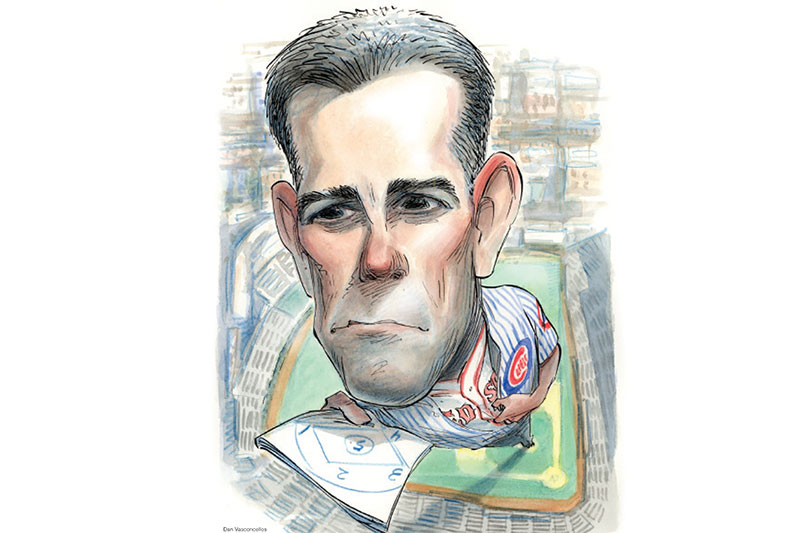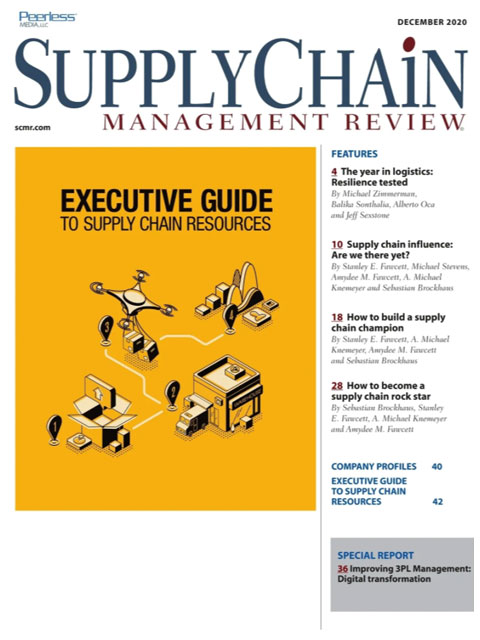Sorry, but your login has failed. Please recheck your login information and resubmit. If your subscription has expired, renew here.
December 2020
Each December, the focus of the issue is our annual Executive Guide to Supply Chain Resources. This is a comprehensive guide to services, products and educational opportunities targeted specifically to supply chain professionals. But, as with years past, we’re also featuring several articles we trust will give you something to think about in the coming year. Browse this issue archive.Need Help? Contact customer service 847-559-7581 More options
On November 2, 2016, the Chicago Cubs did the unthinkable:
They won the World Series after coming back from a 1-3 deficit to the Cleveland Indians. For Cubs fans, the victory marked the end of a 108-year streak of competitive futility. Although the Cubs game seven, extra-inning victory is inspirational, you may be wondering: “As a supply chain professional, why should I care?” Answer: Because Theo Epstein, the Cubs President of Baseball Operations, knows how to build a championship team, a task that is likely high on your to-do list. Vitally, Epstein’s role in the Cubs turnaround wasn’t a fluke. In 2004, Epstein, as Red Sox General Manager, helped Boston vanquish the Curse of the Bambino and end an 86-year title drought.
Deciphering how Theo Epstein took the Cubs, a perennial loser, to a World Series championship has been a hot topic in the sports world. Based on our 20-plus years working with supply chain leaders, we argue that Theo Epstein’s job assembling a champion on the field is a model for the supply chain leader’s quest to build a winning supply chain. Let’s take a closer look at how Epstein transformed the Cubs into champions. His approach highlights five principles of supply chain design that we call the 5Rs (Figure 1). The 5Rs have enabled companies from Amazon to Zara to win on the world’s toughest playing field—today’s global marketplace.
Know the rules and break them when necessary
If you want to win on the baseball field—or in the marketplace—you need to know the rules of the game. The rules define not just your strategy and value-added capabilities, but also your team’s composition. Rules, however, change and disrupt industries and dethrone champions. For proof, look no further than A&P, Compaq and Pan Am. Thus, it’s not enough to know the rules; you also need to pay attention to how they are changing. Spotting inflection points before rivals—and responding effectively—can give you a competitive edge. Andy Grove modeled this reality when he made the case for Intel to make the leap from RAM/DRAM to CPUs before the memory market crashed. Grove’s anticipation of a threat before it was widely discerned is a big reason you know the phrase “Intel Inside.”

This complete article is available to subscribers only.
Log in now for full access or start your PLUS+ subscription for instant access.
SC
MR
Sorry, but your login has failed. Please recheck your login information and resubmit. If your subscription has expired, renew here.
December 2020
Each December, the focus of the issue is our annual Executive Guide to Supply Chain Resources. This is a comprehensive guide to services, products and educational opportunities targeted specifically to supply chain… Browse this issue archive. Access your online digital edition. Download a PDF file of the December 2020 issue.On November 2, 2016, the Chicago Cubs did the unthinkable:
They won the World Series after coming back from a 1-3 deficit to the Cleveland Indians. For Cubs fans, the victory marked the end of a 108-year streak of competitive futility. Although the Cubs game seven, extra-inning victory is inspirational, you may be wondering: “As a supply chain professional, why should I care?” Answer: Because Theo Epstein, the Cubs President of Baseball Operations, knows how to build a championship team, a task that is likely high on your to-do list. Vitally, Epstein’s role in the Cubs turnaround wasn’t a fluke. In 2004, Epstein, as Red Sox General Manager, helped Boston vanquish the Curse of the Bambino and end an 86-year title drought.
Deciphering how Theo Epstein took the Cubs, a perennial loser, to a World Series championship has been a hot topic in the sports world. Based on our 20-plus years working with supply chain leaders, we argue that Theo Epstein’s job assembling a champion on the field is a model for the supply chain leader’s quest to build a winning supply chain. Let’s take a closer look at how Epstein transformed the Cubs into champions. His approach highlights five principles of supply chain design that we call the 5Rs (Figure 1). The 5Rs have enabled companies from Amazon to Zara to win on the world’s toughest playing field—today’s global marketplace.
Know the rules and break them when necessary
If you want to win on the baseball field—or in the marketplace—you need to know the rules of the game. The rules define not just your strategy and value-added capabilities, but also your team’s composition. Rules, however, change and disrupt industries and dethrone champions. For proof, look no further than A&P, Compaq and Pan Am. Thus, it’s not enough to know the rules; you also need to pay attention to how they are changing. Spotting inflection points before rivals—and responding effectively—can give you a competitive edge. Andy Grove modeled this reality when he made the case for Intel to make the leap from RAM/DRAM to CPUs before the memory market crashed. Grove’s anticipation of a threat before it was widely discerned is a big reason you know the phrase “Intel Inside.”
SC
MR


Latest Supply Chain News
- Made in Mexico, manufactured by China
- Retail sales see gains in October, reports Commerce and NRF
- Balancing green and speed: Home delivery insights from the pandemic era
- AdventHealth named top healthcare supply chain by Gartner
- Geopolitical readiness in supply chains: Strategic challenges for leaders
- More News
Latest Podcast

 Explore
Explore
Business Management News
- Made in Mexico, manufactured by China
- Retail sales see gains in October, reports Commerce and NRF
- Balancing green and speed: Home delivery insights from the pandemic era
- AdventHealth named top healthcare supply chain by Gartner
- Unlocking retention: The role employee engagement plays
- Can supply chain managers embrace an entrepreneurial mindset?
- More Business Management
Latest Business Management Resources

Subscribe

Supply Chain Management Review delivers the best industry content.

Editors’ Picks





